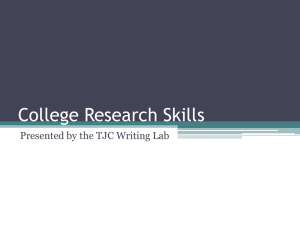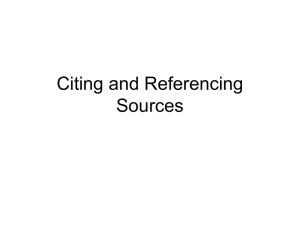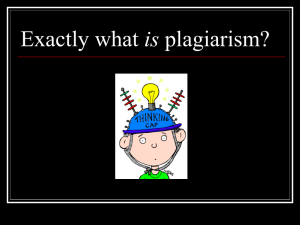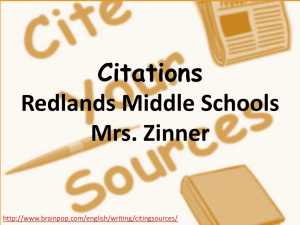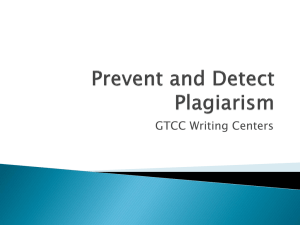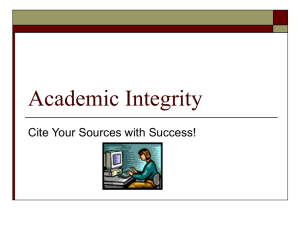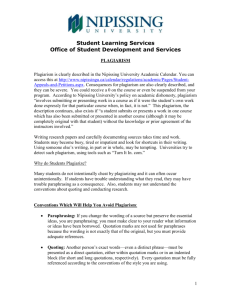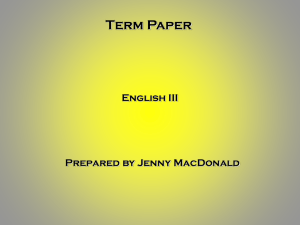Quoting, Paraphrasing, and Summarizing Research
advertisement
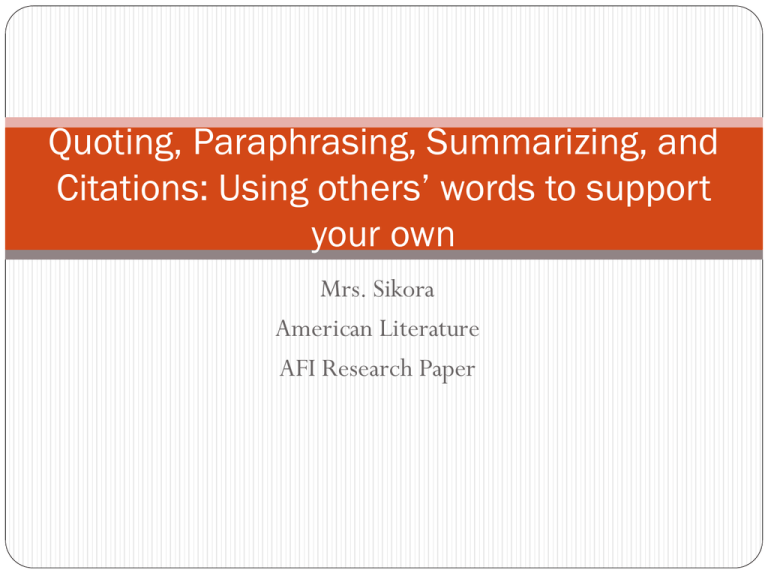
Quoting, Paraphrasing, Summarizing, and Citations: Using others’ words to support your own Mrs. Sikora American Literature AFI Research Paper So what does it mean? Paraphrasing = I’m saying in my own words what I’ve borrowed from an authority. It is important material that needs expression in my own words in about the same length as the original. Summarizing = I’m saying very succinctly what the authority used many words to say. The writer’s long paragraph needs reduction to one phrase or sentence; the author’s ideas may become a short but key sentence in my paper. Quotations = The writer says it much better than I ever could. The material is stated eloquently by an authority, and my rewriting may distort or alter the meaning. I am using quotation marks around the entire passage. Paraphrasing: Putting it in your own words You paraphrase when you take a specific passage from another writer and Recast the content and ideas of the author entirely in your own words—without quoting—and with different sentence structures. Write the paraphrase the approximate length of the original. Avoid “plagiaphrasing,” which is “changing only a few words in the original and then including the text as your own. Plagiaphrasing describes a writer’s use of almost the same words as in the original source” (Keene and Adams 181). *This is a very common form of plagiarism. Introduce the author and possibly reference the title of the book, article, or other source through a “signal phrase” using the present tense (Aaron 466). Cite the page or paragraph number after the information using a parenthetical citation format. Summarizing: Saying it in a concise way You create a summary when you take all or part of a work from another writer (a passage from a Web site, a section of an article, a chapter, an entire article or book…) and Condense what the author is saying, creating a much more concise version that focuses in on the author's main point(s) in your own words. If choosing to retain key phrases or terms from the original, put these terms in quotation marks; however, anything that is your own should NOT be in quotation marks. When you work this summary into your paper, you need to introduce the author and possibly reference the book or article in a “signal phrase” using the present tense (Aaron 466). Use a parenthetical citation after the information. Quoting: Saying it just the way they did You quote when you reproduce a statement from another writer and Use quotation marks around words, phrases, sentences, passages, or paragraphs taken from the other writer’s work, making sure the quotation is accurate-word-for-word, comma-for-comma. Use square brackets to indicate any words you add for clarification (The witness claimed that “he [the suspect] didn’t do it”) or small changes—like making the first letter in a word letter lower case instead of Upper Case—that make the quote fit more smoothly into your sentence (You can also make additions to the quotation or changes if they do not affect its meaning. Insert ellipsis marks (…) to show where you cut unnecessary words or content from a quotation (Van Rys, et al. 155), as in this example: In the Gettysburg Address, Lincoln refers back to the Declaration of Independence when he says “Four score and seven years ago, our fathers brought forth…a new nation…dedicated to the proposition that all men are created equal.” Introduce the author and possibly reference the book or article through a “signal phrase” (Aaron 466). Cite the page number using a parenthetical citation format after the quotation mark. Remember that the period goes after the citation. Paraphrasing versus Summarizing The original passage: Students frequently overuse direct quotation in taking notes, and as a result they overuse quotations in the final [research] paper. Probably only about 10% of your final manuscript should appear as directly quoted matter. Therefore, you should strive to limit the amount of exact transcribing of source materials while taking notes. Lester, James D. Writing Research Papers. 2nd ed. (1976): 46-47. A legitimate paraphrase: In research papers students often quote excessively, failing to keep quoted material down to a desirable level. Since the problem usually originates during note taking, it is essential to minimize the material recorded verbatim (Lester 46-47). An acceptable summary: Students should take just a few notes in direct quotation from sources to help minimize the amount of quoted material in a research paper (Lester 46-47). A plagiarized version: Students often use too many direct quotations when they take notes, resulting in too many of them in the final research paper. In fact, probably only about 10% of the final copy should consist of directly quoted material. Thus, it is important to limit the amount of source material copied while taking notes. What is plagiarism??? A helpful guide in avoiding plagiarism What is Plagiarism? From the Latin word plagiarius: “kidnapper” (MLA, 2009) “To commit literary theft and to present as new and original an idea or product derived from an existing source” (Merriam Webster’s Collegiate Dictionary, 2003) So, when is it plagiarizing? Plagiarism, according to the Saint Viator handbook, is defined as “A form of cheating that involves presenting as one’s own, the ideas or work of another. This means submitting others’ work (print, electronic, or oral) in whole or in part without thoroughly citing its origin” (15). Basically, it’s plagiarism if you didn’t come up with it yourself, and you’re trying to pass it off as your own. Plagiarism can be intentional and unintentional. Plagiarism is… Copying a source verbatim and incorporating it into your paper without quoting and citing it Copying a source verbatim without quoting it even if you include a citation. Copying even one line from another source verbatim without quoting it (even if you include a citation). Paraphrasing a source and failing to provide a citation. Replacing a few words with synonyms even if you include a citation. Plagiarism is not… Summarizing or paraphrasing another source and providing a citation. Placing quotations marks around any portion of text that was taken verbatim from another source and citing it. Writing your unique ideas or commenting on another source. Writing about common knowledge. I think I get it… Plagiarism isn’t just buying a paper off of a website or another student. It includes: Not citing a source used, even when you’re not using a direct quote. If you’re paraphrasing or summarizing, you MUST cite it. Using a sibling’s or friend’s paper, even just a portion of it. Copying and pasting from a website. Copying your friend’s worksheet in study, at lunch, etc. Buying, stealing, or borrowing a paper (including, of course, copying an entire paper or article from the Web); hiring someone to write your paper for you; and copying large sections of text from a source without quotation marks or proper citation. When in doubt, CITE IT! You don’t want your teacher to misinterpret your intentions. Academic Dishonesty Academic dishonesty doesn’t just include plagiarism. Cheating (“Any attempt to deceive or mislead the teacher in arriving at an honest evaluation of learning. Cheating includes helping others to cheat, using notes, cheat sheets, etc” (15).) Furnishing false information--- All work (homework, quizzes, tests), unless indicated by the teacher, MUST be completed by the individual student. Buying/selling materials: tests, quizzes, study guides, papers, etc. Stealing answer keys. Use of cell phones before, during, and after finals. What’s the punishment? First violation A zero on the assignment or test Saturday detention A phone call to your parents Academic misconduct goes on your disciplinary file You must meet with your counselor You’re dismissed from all honor societies You may be removed from leadership positions Questions??? When in doubt, consult your student handbook (pages 14- 16). Ask your teacher!!! Cite, cite, cite! It’s better to over-cite than to be accused of plagiarism! Works Cited Aaron, Jane E. LB Brief, 3rd ed. New York: Longman, 2008. Print. Keene, Michael L, & Adams, Katherine. H.. Easy Access. New York: McGraw-Hill, 2006. Print. The Purdue OWL. Purdue U Writing Lab, 2010. Web. 3 May 2012. Van Rys, John, Verne Meyer, & Pat Sebranek. The Business Writer. Boston: Houghton Mifflin, 2006. Print.
